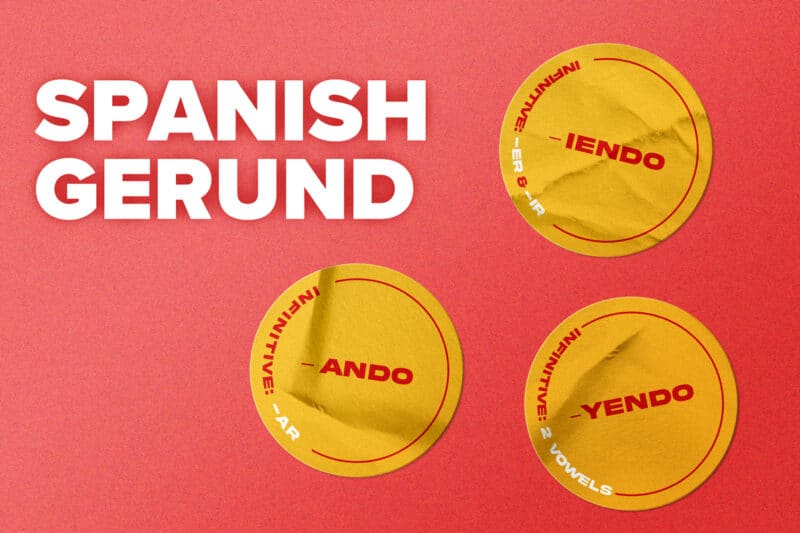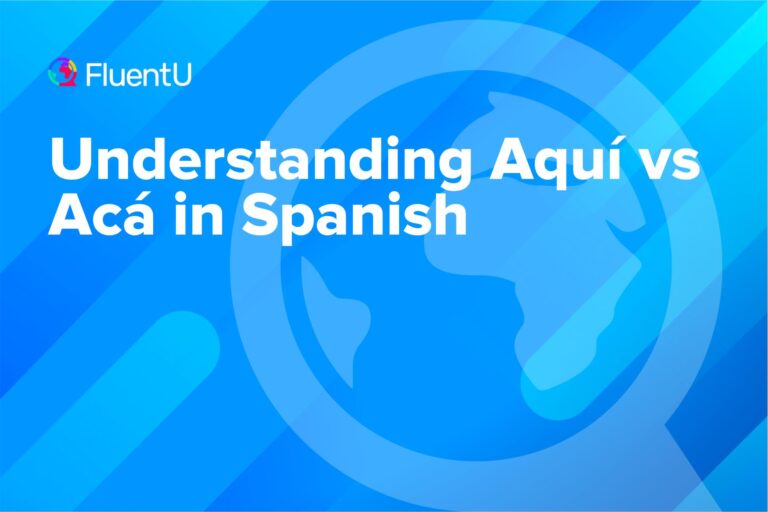How to Form and Use the Gerund in Spanish

Did you know that you can give orders, descriptions and exclamations all with the gerund in Spanish? same word in Spanish? Most likely you already know a little about gerunds, the –iendo or –ando form of verbs (corriendo, andando). And if you do, you’re ready to start using the gerund in Spanish in all sorts of different situations.
Let’s have a look at the many ways we can use the ever-versatile gerund.
Download: This blog post is available as a convenient and portable PDF that you can take anywhere. Click here to get a copy. (Download)
What is the Gerund in Spanish?
The gerund is a verb form that expresses continuous action (an action that is currently happening). It’s equivalent to the “–ing” form of a verb in English.
It’s important to recognize that while English gerunds act as nouns, Spanish gerunds will always remain a verb.
Here are some examples of gerunds:
Estoy cenando. (I am eating dinner.)
Mi abuela está hablando con su hermana. (My grandma is talking with her sister.)
Andamos buscando el teléfono de Juan. (We’re walking around looking for Juan’s phone.)
How to Form a Gerund in Spanish
Use this formula to form the gerund:
infinitive verb stem + -ando or -iendo
This table demonstrates what this looks like:
| Verb Type | Gerund Ending | Example |
|---|---|---|
| -ar | -ando | Bajar → Bajando |
| -ar | -iendo | Comer → Comiendo |
| -ir | -iendo | Abrir → Abriendo |
As always, there are some exceptions to the normal formula!
For one, verbs that end in two vowels will use –yendo to form the gerund:
Caer → cayendo
Oír → oyendo
And then there are the real funky ones, the stem-changers. These are easiest to remember if you just memorize which verbs they are, though there are some guidelines that can help:
- If there’s a e to i/ie change in the present tense, the gerund will have i in the stem
Pedir → pidiendo
Preferir → prefiriendo
- If there’s a o to ue change in the present tense, the gerund will have u in the stem
Dormir → durmiendo
Poder → pudiendo
Most Common Gerunds in Spanish
There are certain Spanish verbs that are commonly made into gerunds. Here are some of the most common regular and irregular Spanish gerunds.
Regular Spanish Gerunds
| Infinitive | Gerund |
|---|---|
| hablar (to talk) | hablando (talking) |
| vivir (to live) | viviendo (living) |
| tomar (to take) | tomando (taking) |
| pensar (to think) | pensando (thinking) |
| comer (to eat) | comiendo (eating) |
| beber (to drink) | bebiendo (drinking) |
| hacer (to do/make) | haciendo (doing/making) |
| tener (to have) | teniendo (having) |
| ser (to be) | siendo (being) |
| llegar (to arrive) | llegando (arriving) |
| salir (to leave) | saliendo (leaving) |
| cocinar (to cook) | cocinando (cooking) |
| bailar (to dance) | bailando (dancing) |
| cantar (to sing) | cantando (singing) |
| poner (to put) | poniendo (putting) |
| ver (to see) | viendo (seeing) |
| necesitar (to need) | necesitando (needing) |
| escribir (to write) | escribiendo (writing) |
| abrir (to open) | abriendo (opening) |
Irregular Spanish Gerunds
| Infinitive | Gerund |
|---|---|
| leer (to read) | leyendo (reading) |
| caer (to fall) | cayendo (falling) |
| creer (to believe) | creyendo (believing) |
| cecir (to say) | diciendo (saying) |
| dormir (to sleep) | durmiendo (sleeping) |
| pedir (to ask for) | pidiendo (asking for) |
| sentir (to feel) | sintiendo (feeling) |
| vestir (to wear) | vistiendo (wearing) |
| mentir (to lie) | mintiendo (lying) |
The more you hear native Spanish spoken, the more you’ll pick up on how to use gerunds and which ones end up being the most common.
When to Use the Spanish Gerund with Other Verbs
Progressive Constructions
In the progressive tenses, the gerund is almost always paired with the verb estar to express an action in motion. It’s something that’s currently happening, right now, at this moment.
Ronaldo está quejándose. (Ronaldo is complaining.)
Javier Bardem me está seduciendo. (Javier Bardem is seducing me.)
This progressive construction can be paired up with just about any verb tense, but just remember that it means that the action is/was/will be continuously happening.
Here’s an example of each progressive construction:
Past progressive: Estuve trabajando como espía en Rusia por diez años. (I was working as a spy in Russia for ten years.)
Present perfect continuous: Hemos estado hablando y decidimos que tu blusa es fea. (We’ve been talking and we decided that your blouse is ugly.)
Future perfect continuous: Elena habrá estado saliendo con Juan por cinco meses en junio. (In June, Elena will have been dating Juan for five months.)
Pluperfect subjunctive: Si hubieras estado prestando atención en la prepa, esto ya lo habrías sabido. (If you had been paying attention in high school, you would have already known this.)
Note that these progressive tenses can’t be used with venir, ir and estar as their main verbs. For example, you cannot say: estoy yendo*, estoy viniendo*, and estoy estando*. These are all incorrect.
With Ir, Andar and Venir
If you want to express a little more emotion, you can use the gerund with ir. In addition, you can use it to express actions that are gradually unfolding over time.
¿Quién va conduciendo el tren? (Who’s driving this train?!)
Poco a poco Ricardo fue convirtiéndose en todo un hombre. (Little by little, Ricardo was becoming a man.)
You can also use the gerund with andar and venir. Using one of these verbs will add the idea of a repeated or insistent action to your sentence.
Roberto viene buscando chicas para conquistar. (Roberto is looking to pick up chicks.)
España anda siempre aguantando millones de huelgas. (Spain is always putting up with tons of strikes.)
Reflexive Gerunds
When a reflexive Spanish verb is made into a gerund that comes after another verb, the reflexive pronoun either comes before the preceding verb, or tacked on to the end of the gerund:
Me estoy lavando las manos. (I’m washing my hands.)
Estoy lavándome las manos. (I’m washing my hands.)
Se están olvidando algo. (They are forgetting something.)
Están olvidándose algo. (They are forgetting something.)
When to Use the Spanish Gerund on Its Own
Now that you’ve got the basics of using a gerund mastered, I’m going to make it all a lot easier for you: you don’t always need to use a main verb.
There are a number of instances when you can use the gerund all by its lonesome without even worrying about estar or having to conjugate anything.
Current Actions
As we just learned, the gerund is used to express that something is in the process of happening. Only this time, you don’t need the main verb.
And here’s the best thing: it can refer to the present, past or future.
¿Qué haces? — Nada, relajándome un poquito. (What are you doing? — Nothing, relaxing a bit.)
¿Y Paz? ¿Qué hacía? — Tomando un té. (And Paz? What was she doing? — Drinking tea.)
How Something Has Been Achieved
Similar to the construction in English, you can use the Spanish gerund to describe how something is done or carried out.
Viajando, conocí muchos países, mucha gente y a mi esposa. (By traveling, I got to know many countries, people and my wife.)
Comiendo mucho, me engordé. (By eating a lot, I got fat.)
Describing Situations
You can use the independent gerund to describe pictures and situations.
Mi hijo, ganando el premio Nobel. (My son, winning the Nobel Prize.)
¿Dónde está la escuela? — Saliendo del metro, a la izquierda. (Where’s the school? — On the left when you get off the metro.)
Exclamations and Interrogatives
Use the gerund when you want to say that you think someone spends too much time doing one thing. Use this with expressions like siempre or otra vez.
¡Otra vez comiendo McDonalds! (Eating McDonalds again? (with all these delicious tapas around?))
¡De nuevo estudiando! (Studying again! (Get outside!))
Sarcasm
You can use the independent gerund for situations in which it’s obvious what’s going on. You can ask questions that don’t require a response this way.
¿Qué? ¿Comiéndote mi tortilla? (Eating my tortilla, I see.)
Giving Orders
You can use the gerund to give orders.
¡Vamos a perder el bus! ¡Corriendo! (We’re going to miss the bus. Run!)
Nunca vas a terminar. Trabajando. (You’re never going to finish. Get to work.)
When Not to Use the Gerund
Although you can use the gerund in a whole bunch of awesome ways, there are a few things you should be careful (ojo) of as well.
First, the gerund isn’t a noun like in English. In Spanish, you must use the infinitive form of the verb if you want the action to act as a noun.
Me gusta nadar. Nadar es divertido. (I like swimming. Swimming is fun.)
The gerund isn’t an adjective either in Spanish. Instead, use a past participle or restructure the sentence.
Los niños que griten serán premiados con una visita al director. (Screaming children will be rewarded with a trip to the principal.)
How to Practice Spanish Gerunds
Now that you know all these new and fabulous ways that gerunds are going to make your life easier, it’s time to put them to practice!
Here are some things to try:
- Find practice exercises online. Bowdoin College has some great exercises, and Lingolía has this free one (there are more, but you’ll need to purchase them).
- Read Spanish books to see how gerunds are written.
- Practice incorporating gerunds into your own speech. The more you use them yourself, the better you’ll understand them.
- Watch Spanish movies to see how gerunds come up in natural speech. FluentU could be a great option for this as it gives you Spanish videos featuring native speakers in natural contexts.
FluentU takes authentic videos—like music videos, movie trailers, news and inspiring talks—and turns them into personalized language learning lessons.
You can try FluentU for free for 2 weeks. Check out the website or download the iOS app or Android app.
P.S. If you decide to sign up now, you can take advantage of our current sale!

Now you can use gerunds to give orders and describe situations, so get out there and use them!
Download: This blog post is available as a convenient and portable PDF that you can take anywhere. Click here to get a copy. (Download)
And One More Thing…
If you've made it this far that means you probably enjoy learning Spanish with engaging material and will then love FluentU.
Other sites use scripted content. FluentU uses a natural approach that helps you ease into the Spanish language and culture over time. You’ll learn Spanish as it’s actually spoken by real people.
FluentU has a wide variety of videos, as you can see here:

FluentU brings native videos within reach with interactive transcripts. You can tap on any word to look it up instantly. Every definition has examples that have been written to help you understand how the word is used. If you see an interesting word you don’t know, you can add it to a vocab list.

Review a complete interactive transcript under the Dialogue tab, and find words and phrases listed under Vocab.

Learn all the vocabulary in any video with FluentU’s robust learning engine. Swipe left or right to see more examples of the word you’re on.

The best part is that FluentU keeps track of the vocabulary that you’re learning, and gives you extra practice with difficult words. It'll even remind you when it’s time to review what you’ve learned. Every learner has a truly personalized experience, even if they’re learning with the same video.
Start using the FluentU website on your computer or tablet or, better yet, download the FluentU app from the iTunes or Google Play store. Click here to take advantage of our current sale! (Expires at the end of this month.)







